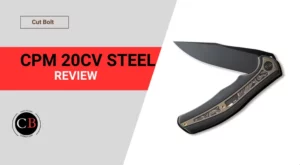Is H1 steel good for knives? Have you ever met the magic knife that never rusts?
Tired of battling blade blues? Say “arrivederci” to rust and hello to H1 steel, the revolutionary knife material that’s taking the edge on performance. This wonder alloy boasts unparalleled corrosion resistance, unyielding toughness, and an addictive ease of sharpening, making it the ultimate companion for salty adventures and everyday tasks alike.
But is H1 steel truly the knight in shining armor it’s touted to be? Buckle up, fellow knife aficionados, because we’re about to dive deep into the world of H1, dissecting its strengths, exploring its quirks, and unveiling whether this steel marvel lives up to the hype. Get ready to sharpen your curiosity, because H1 is ready to rock your world!
What is H1 steel?
H1 steel is a high-carbon, high-chromium stainless steel known for its exceptional corrosion resistance. It is a non-magnetic steel developed by Myodo Metal, Japan. H1 steel boasts absolute rust immunity, making it an excellent choice where resistance to corrosion from saltwater or other harsh environments is crucial, such as in marine environments, diving knives, and fishing tools. It is a precipitation-hardening processed alloy categorized as a PH steel, having undergone a hard rolling process without heat treatment. What sets H1 apart is its unique composition with 0.1% nitrogen, functioning similarly to carbon but without reacting to chlorine, ensuring rust resistance.
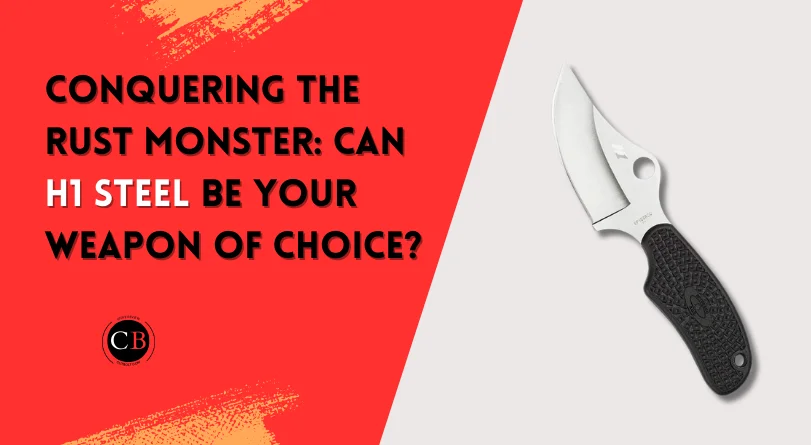
Composition of H1 steel
| Element | Portion | Effect |
| Chrome | 16.0% | Improves wear resistance, heat resistance and scale resistance. It increases tensile strength because it acts as a carbide former. Use of rust-free or stainless steel, as it increases corrosion resistance from a mass proportion of 12.2%. Reduction in weldability. |
| Carbon | 0.15% | Increasing hardness and tensile strength. In larger quantities, increase in brittleness and reduction in forgeability and weldability. |
| Copper | 0.10% | Improving weather resistance (surface oxidation). |
| Manganese | 2.00% | Improves hardness and tensile strength. |
| Molybdenum | 1.50% | Improves hardenability, tensile strength and weldability. Reduction in forgeability and ductility. |
| Nickel | 8.00% | Nickel increases tensile strength and yield strength. From 8% increase in corrosion resistance. |
| Phosphorus | 0.04% | Increases tensile strength, hardness and corrosion resistance but also brittleness. |
| Sulfur | 0.03% | Increases machinability but also brittleness. |
| Silicon | 4.50% | Improves strength. |
| Nitrogen | 0.10% | Austenite former, increasing strength and corrosion resistance. |
H1 steel is a low carbon content and a high nickel content stainless steel. A combination that is a rather rare composition in the knife industry.
What is the hardness of H1 steel?
The hardness of H1 steel is often in the range of 57-58 HRC (Rockwell Hardness Scale), which is moderate but sufficient for its intended applications, such as dive knives and tools for use in saltwater conditions. Keep in mind that the emphasis with H1 steel is on its ability to resist rust and corrosion rather than achieving extreme hardness.
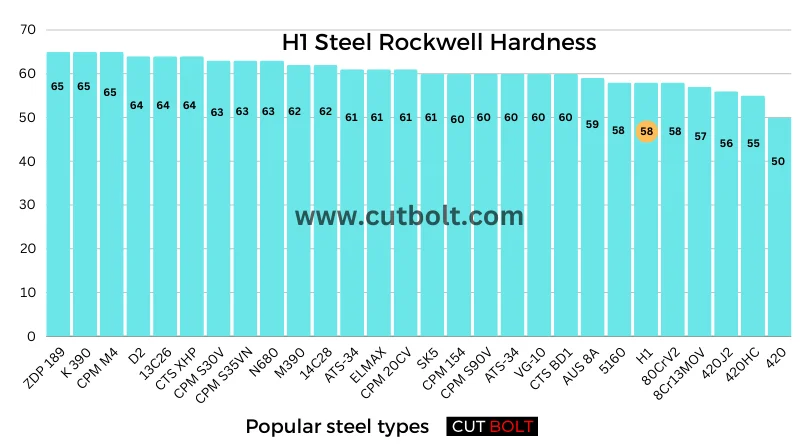
Properties of H1 steel
Depending on its chemical composition and hardness, H1 stainless steel offers the following properties:
- Corrosion Resistance: This is H1’s shining star. The nitrogen replacing carbon as the strengthening element creates a highly stable microstructure, rendering it practically immune to rust. Saltwater, acidic environments, and even chlorine pose no threat, making it ideal for marine applications, outdoor tools, and knives that see frequent cleaning.
- Toughness: Despite its lower hardness compared to high-carbon steels, H1 exhibits outstanding toughness. Its microstructure incorporates soft ferrite grains and lacks brittle carbides, allowing it to bend and flex without chipping or breaking. Think of it as a resilient blade that can handle tough tasks without fear of shattering.
- Sharpening Ease: This is where H1 truly shines for everyday users. Due to its unique composition, it sharpens quickly and easily on a variety of stones, even for those without extensive sharpening experience. You won’t need hours on a whetstone to restore its bite, making it a low-maintenance option.
- Edge Retention: Although H1 sharpens easily, its edge retention isn’t on par with the highest-performing steels. It won’t stay razor-sharp like some high-carbon varieties, particularly under demanding tasks. However, it holds its edge well enough for most everyday cutting needs and re-sharpening is a breeze.
- Hardness: H1 sits on the lower end of the hardness spectrum for knife steels. This translates to slightly less edge-biting prowess compared to harder steels. It may not be your go-to for ultra-thin slicing tasks, but its toughness and corrosion resistance often outweigh this trade-off.
- Non-reactivity to Chlorine: The nitrogen in H1 steel acts similarly to carbon but does not react with chlorine. This characteristic ensures that the steel does not form chlorides, which can lead to rust. This non-reactivity to chlorine is particularly advantageous in environments where exposure to chlorine is a concern.
- Rolling Process: H1 steel is rolled hard without undergoing traditional heat treatment. This process contributes to its unique combination of properties, emphasizing corrosion resistance over extreme hardness.
- Applications: H1 steel is commonly used in the production of dive knives, cutting tools, and other equipment that requires resistance to corrosion in marine and saltwater conditions.
Other properties of H1 steel:
- Wear resistance is moderate, not exceptional.
- Good low-temperature performance.
- Relatively easy to machine and fabricate.
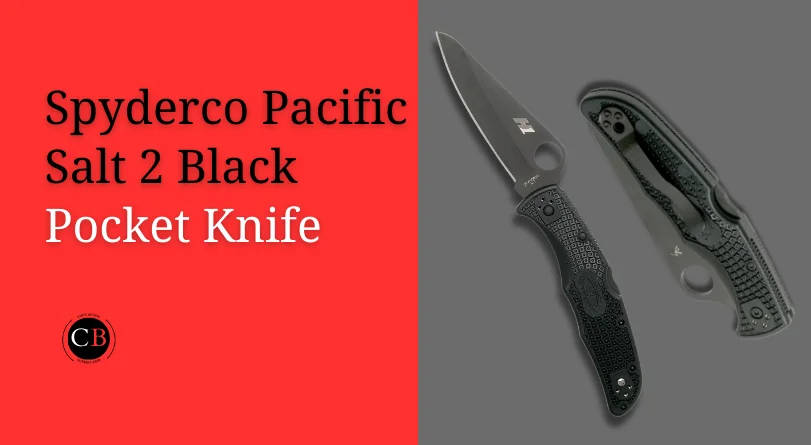
Related: How good is HAP40 steel for knives?
Is H1 a good knife steel?
Whether H1 steel is “good” for a knife depends entirely on what you value in a blade. It’s like judging a marathon runner by their basketball skills – both excel in their own fields. H1 shines in areas where other steels might struggle, but it comes with trade-offs.
Here’s the deal: H1 boasts near-mythical corrosion resistance. Saltwater, acidic environments, even chlorine – forget about rust. This makes it a champion for water-based adventures, from diving trips to messy kitchens. Plus, it’s incredibly tough, able to bend and flex without chipping, making it perfect for rough-and-tumble tasks. And the best part? Sharpening it is a breeze – no hours honing on whetstones here.
However, remember the marathon runner? Like them, H1 prioritizes endurance over sprinting. Its edge won’t stay razor-sharp like some high-carbon steels, needing more frequent touch-ups, and it’s slightly less bitey due to its lower hardness. Think of it as a reliable companion, not a delicate precision tool.
So, is H1 steel good? That’s up to you. If you prioritize rust-proofing, toughness, and easy maintenance, H1 is a fantastic choice. But if you need absolute peak sharpness or a slicing demon, other steels might be a better fit. Ultimately, the perfect knife steel is a personal journey, and H1 could be the ideal travel buddy for your adventures.
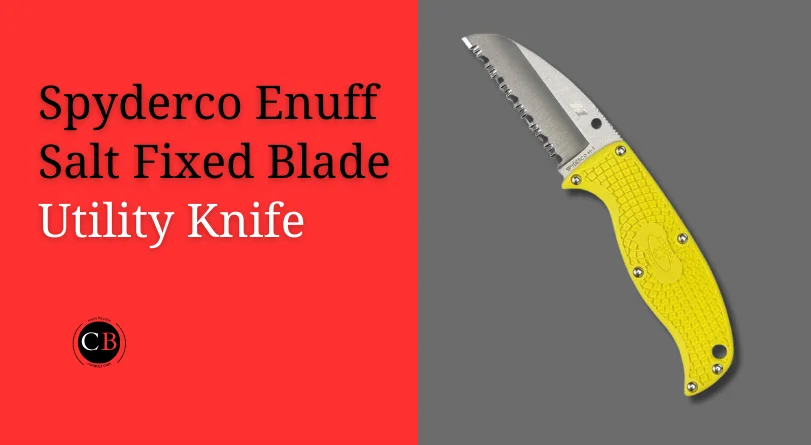
H1 steel alternative
When it comes to alternative steels for H1, it depends on what specific qualities you’re looking to match or surpass. Here are a few options, each with its own strengths and weaknesses:
AUS-8 comes pretty close to H1 steel. It too offers exceptional corrosion resistance, good wear resistance, good edge retention, and both hardness and price are at a similar level.
For Corrosion Resistance:
- N680: This Austrian steel boasts even better corrosion resistance than H1, making it a top choice for saltwater environments and high-chlorine settings like swimming pools. It’s slightly tougher than H1 but also holds its edge a bit better. Think of it as H1’s slightly sharper, saltier cousin.
- LC200N (Z-Finit): This Swedish steel is another champion of corrosion resistance, rivaling N680 and surpassing H1. It’s also incredibly tough and wear-resistant, making it ideal for heavy-duty use. However, it’s less common and more expensive than H1.
For Edge Retention:
- S30V: This American steel offers exceptional edge retention and wear resistance, making it a popular choice for hunting and tactical knives. While not as rust-resistant as H1, it still performs well in most environments. Think of it as the sharp, durable alternative.
- CPM 154: Another American steel, CPM 154 delivers excellent edge retention and wear resistance while offering moderate corrosion resistance. It’s a well-rounded option for everyday carry knives that need to stay sharp and handle various tasks.
For Toughness:
- Cruwear: This American steel is renowned for its toughness and wear resistance, making it a favorite for heavy-duty knives used for chopping, prying, and other demanding tasks. While not as rust-resistant as H1, it holds up well in most environments. Think of it as the unbreakable workhorse option.
- Elmax: This Swedish steel is another tough contender, offering excellent wear resistance and chipping resistance. While its corrosion resistance isn’t as impressive as H1, it’s still a good choice for outdoor and everyday use. Think of it as the durable all-rounder option.
The best alternative to H1 steel depends on your specific needs and priorities. Consider what qualities are most important to you and choose the steel that best fits your needs. Remember, there’s no one-size-fits-all answer, so explore your options and find the perfect blade companion for your adventures!
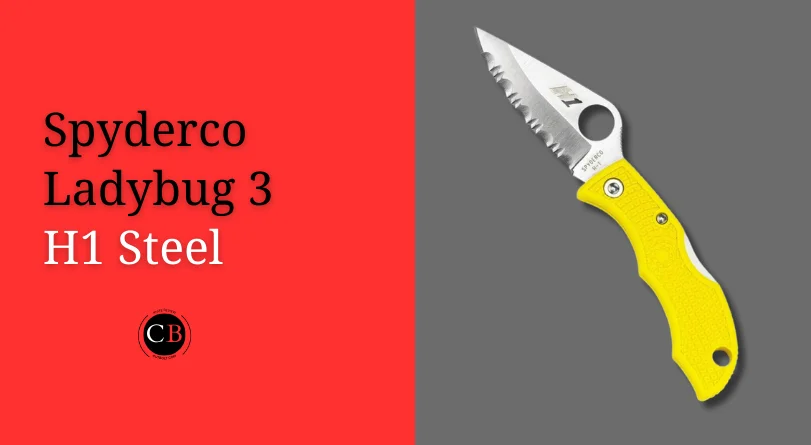
Final Words: Is H1 steel good for knives?
For those who navigate salty currents, H1 shines like a lighthouse. Its near-mythical corrosion resistance laughs in the face of chlorine, sweat, and even the briny depths. Whether you’re diving into coral reefs or tackling sweaty kitchen chores, H1 shrugs off rust with nonchalant ease.
Its toughness is another anchor against the storm. This resilient steel bends like a seasoned sailor, absorbing shocks and resisting chipping like a seasoned swordsman. Think of it as the ship’s mast, taking on hefty tasks without splintering or breaking.
But, like any seasoned sailor knows, smooth sailing demands more than just resilience. H1, while quick to take an edge, doesn’t hold it as long as some of its sharper brethren. Picture it as a sturdy cutlass, slicing through hearty ropes and canvas effortlessly, but not quite nimble enough for delicate silks.
And remember, even the sturdiest schooner struggles against strong currents. H1’s lower hardness compared to other tough steels translates to slightly less bite for intricate tasks. Think of it as navigating narrow straits – while it can handle the journey, a more agile craft might be better suited for precision maneuvering.
So, is H1 good for knives? It’s not a universal yes or no. It’s a matter of charting your course and knowing what winds fill your sails. If resilience against the elements, ease of maintenance, and a reliable bite for everyday tasks are your priorities, then H1 might be your ideal vessel. But if your voyage demands razor-sharp precision and slicing through the toughest challenges, other steels might be your better bet.
Ultimately, the perfect knife steel is a personal journey. Set sail with an open mind, explore your options, and find the blade that sings your seafaring song. Fair winds and following seas!


